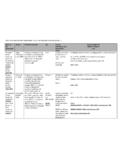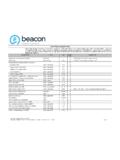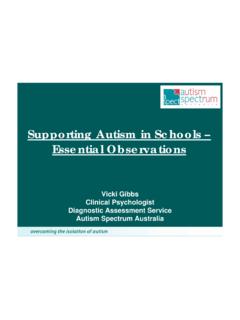Transcription of PRESCHOOL PTSD TREATMENT - Tulane Institute
1 PRESCHOOL ptsd TREATMENT Version Updated October 14, 2010 Michael S. Scheeringa, MD, MPH Department of Psychiatry and Neurology Section of Child and Adolescent Psychiatry Tulane University Health Sciences Center New Orleans, LA Lisa Amaya-Jackson, MD, MPH Department of Psychiatry and Behavioral Sciences Duke University Medical Center Durham, NC Judith Cohen, MD Center for Traumatic Stress in Children and Adolescents Allegheny General Hospital Pittsburgh, PA Copyright 2002 by Scheeringa, Cohen, and Amaya-Jackson Address correspondence to Dr. Scheeringa, 1440 Canal St.
2 , TB52, New Orleans, LA 70112. PPT Manual 2 INTRODUCTION Manual Development PRESCHOOL ptsd TREATMENT (PPT) is a theory-driven, manualized protocol based on cognitive-behavioral therapy (CBT) with modifications for young children. Some of these modifications involve parent-child relationship dynamics that are salient for this age group. The manual was created for use in a trial for 3-6 year-old children. Three years of age is about the lower limit at which children can understand and cooperate with CBT techniques. Use with children older than 6 years is possible with adaptations.
3 PPT has similarities with Cognitive-Behavioral Therapy for Sexually Abused PRESCHOOL Children (CBT-SAP) (Cohen and Mannarino, 1996) and Trauma Focused Coping (TFC) for 8 to 18 year-old children (March and Amaya-Jackson, 1998). Some of the techniques of CBT-SAP were modified to adapt the protocol to other types of interpersonal traumas. Some of the techniques of TFC were modified to adapt that protocol to PRESCHOOL children and the parent-child relationship. Modifications were also based on empirical data from the research on the assessment of ptsd in PRESCHOOL children (Scheeringa et al.)
4 , 1995, 2001; Scheeringa and Zeanah, 2001), the authors clinical experiences, and pilot data in this population. One proof-of-concept paper has been published based on this manual (Scheeringa et al., 2007). i. Cognitive-Behavioral TREATMENT for ptsd CBT is an effective TREATMENT modality for ptsd because of the focus on learning theories and cognitive distortions. While it is not known what causes ptsd at the neurocircuitry level, it is evident that these are new behaviors, thoughts, and feelings that were not present prior to a traumatic event that seem to be driven by magnified and automatic cognitive processes.
5 Behavior therapy rests on a primary assumption that most behavior develops and is sustained through the principles of learning (Rimm & Masters, 1979). One type of learning, operant conditioning (Skinner, 1953), is particularly useful for TREATMENT because it works by voluntary behaviors (operants) being reinforced by consequences (response). In theory, change in behavior is linked to the strength and frequency of the responses. These characteristics can be manipulated in TREATMENT protocols. Cognitive therapy rests on the primary assumption that individuals interpret the world through cognitive structures (schemas) that have secondary impacts on altered feelings and behaviors (Beck, 1967).
6 Cognitions and behaviors are, of course, not independent, and theorists have sought a more realistic amalgam of the two, such as in social learning theory (Bandura, 1969). Cognitive-behavioral therapy (CBT) is the rational blending of both modalities, which over the past 30 years has evolved into a diverse group of interventions (Thase & Wright, 1997). The empirically-driven theory and practice of CBT lend it well to systematic and structured TREATMENT protocols. CBT techniques can be simplified into two components: exposures (systematic desensitization, and prolonged/imaginal exposure) and anxiety management training (relaxation, cognitive restructuring, and biofeedback).
7 Empirical support exists for both categories, plus for combined TREATMENT packages (reviewed in Rothbaum & Foa, 1996). A review of studies identified three factors that were involved in successful treatments: emotional engagement with the trauma memory, organization and articulation of a trauma narrative, and modification of basic core beliefs about the world and about oneself (Zoellner, Fitzgibbons, & Foa, 2001). We will address all three of these in this manual. The challenge in working with younger children is how to apply these techniques in a developmentally-sensitive fashion that both the child and parent can PPT Manual 3make use of.
8 The ways that we have addressed these developmental challenges are discussed throughout the manual. Two groups have demonstrated the effectiveness of CBT techniques in younger traumatized children. Cohen and Mannarino (1996a) (3- to 6-year-old children) and Deblinger, Stauffer, and Steer (2001) (2- to 8-year-old children) showed superiority in TREATMENT outcome of CBT techniques in randomized trials. Their groups were limited to sexually abused children and they did not have to have ptsd to be included. The March and Amaya-Jackson (March et al., 1998) and Cohen and Mannarino (1996a) manuals were blended and modified into a manual for this proposal.
9 The studies that demonstrated the effectiveness of their manuals will be discussed in more detail below. The Cohen and Mannarino Manual Cohen (Judith) and Mannarino (1996a) manualized a 12-session CBT protocol for sexually-abused PRESCHOOL children (CBT-SAP). In addition to using traditional CBT techniques with the children, such as detecting distorted attributions, thought stopping, positive imagery, and progressive relaxation, the sessions included time spent with the mothers. Their manual systematically addressed mother s ambivalence about the abuse, fears about their children s future, new skills to provide emotional support to the children, parent management training, and issues about mothers own histories of abuse.
10 Therapist adherence to these issues was confirmed with independent ratings of audiotaped sessions. Sixty-seven 3- to 6-year old children were randomized to either CBT-SAP or nondirective supportive therapy (NST). Thirty-nine children completed the CBT-SAP protocol and 28 completed the NST protocol. Outcome measures were CBCL broad band scales (Internalizing, Externalizing, Total, and Social Competence), Child Sexual Behavior Inventory scores, and weekly ratings of 21 behavior problems. The CBT-SAP group significantly improved on all of these outcome measures except the CBCL Social Competence scale.






